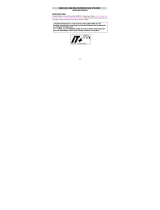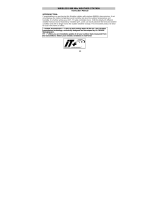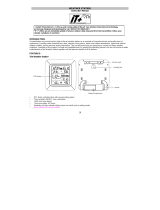Page is loading ...

23
WIRELESS 868 MHz TEMPERATURE STATION
Instruction Manual
INTRODUCTION:
Congratulations on purchasing this tiny 868MHz Temperature Station which displays the time, indoor
temperature, and outdoor temperature readings. With only four easy to use keys, this product is ideal
for use in the home or office.
FEATURES:
LCD
Display
Hanging
Hole
Battery
compartment
cover
Foldout
stand
Function
Keys

24
The Temperature Station
•
Quartz clock in 12 or 24-hour time display (hour and minute, manually set)
•
Indoor and outdoor temperature reading in degree Celsius (°C) or Fahrenheit (°F)
•
Minimum and Maximum records of indoor temperature and outdoor temperature
•
Can receive up to three outdoor transmitters
•
Wireless transmission at 868 MHz
•
Signal reception intervals at 4 seconds
•
Low battery indicator
•
Wall mounting or table standing (foldout table stand included)
The Outdoor Temperature Transmitter
•
Remote transmission of outdoor temperature to Temperature Station by
868 MHz
•
Shower proof casing
•
Wall mounting case (Mounting at a sheltered place. Avoid direct rain and
sunshine)

25
SETTING UP:
When one transmitter is used:
1. First, insert the batteries into the transmitter (see “How to install and replace batteries in the
Temperature transmitter” below).
2. Within 2 minutes of powering up the transmitter, insert the batteries to the Temperature Station
(see “How to install and replace batteries in the Temperature Station” below). Once the
batteries are in place, all segments of the LCD will light up briefly. Then the indoor temperature
and the time as 0:00 will be displayed. If they are not shown on LCD after 60 seconds, remove
the batteries and wait for at least 60 seconds before reinserting them. Once the indoor data is
displayed, user may proceed to the next step.
3. After the batteries are inserted, the Temperature Station will start receiving data signal from the
transmitter.
4. The outdoor temperature should be displayed on the Temperature Station. Also, the signal
reception icon will be displayed. If this does not happen after 2 minutes, the batteries will need to
be removed from both units and reset from step 1.
5. In order to ensure sufficient 868 MHz transmission, the final position between the Temperature
Station and the transmitter should not be more than 100 meters (see notes on “Positioning”
and “868 MHz Reception”).

26
When more than one transmitter is used
1. User shall remove all the batteries from the temperature station and transmitters and wait 60
seconds if setting has been done with one transmitter before.
2. Insert the batteries to the first transmitter.
3. Within 30 seconds of powering up the first transmitter, insert the batteries to the Temperature
Station. Once the batteries are in place, all segments of the LCD will light up briefly. Then the
indoor temperature and the time as 0:00 will be displayed. If they are not shown in LCD after 60
seconds, remove the batteries and wait for at least 60 seconds before reinserting them.
4. The outdoor temperature from the first transmitter (channel 1) should be displayed on the
Temperature station. Also, the signal reception icon will be displayed. If this does not happen
after 40 seconds, the batteries will need to be removed from both units and reset from step 1.
5. Insert the batteries to the second transmitter immediate after (in 10 seconds after) inserting
battery to the temperature station.
6. The outdoor temperature from the second transmitter and the "channel 2" icon should then be
displayed on the Temperature station. If this does not happen after 40 seconds, the batteries will
need to be removed from all the units and reset from step 1.
7. Insert the batteries to the third transmitter immediate after (in 10 seconds after) inserting battery
to the second transmitter.

27
8. Then within 40 seconds, the channel 3 outdoor data from the third transmitter will be displayed
and the channel icon will shift back to "1" once the third transmitter is successfully received. If
this is not happen, user shall restart the setting up from step 1.
.
Note:
After the three transmitters have been set up, user may need to check the readings displayed on the
temperature station against those being shown on the transmitter displays, in order to recognise on
which channel each transmitter is being presented.
IMPORTANT:
Transmission problems will arise if the setting for additional sensors is not followed as described above.
Should transmission problems occur, it is necessary to remove the batteries from all units and start
again the set-up from step 1.

28
HOW TO INSTALL AND REPLACE BATTERIES IN THE
TEMPERATURE STATION
The Temperature Station uses 2 x AAA, IEC LR3, 1.5V batteries. When
batteries will need to be replaced, the low battery icon will appear on the LCD.
To install and replace the batteries, please follow the steps below:
1. Lift up the battery compartment cover.
2. Insert batteries observing the correct polarity (see marking).
3. Replace compartment cover.
HOW TO INSTALL AND REPLACE BATTERIES IN THE TEMPERATURE
TRANSMITTER
The Temperature transmitter uses 2 x AA, IEC LR6, 1.5V batteries. When batteries will
need to be replaced, the low battery icon will appear on the LCD of the Temperature
Station. To install and replace the batteries, please follow the steps below:
1. Remove the battery compartment cover.
2. Insert the batteries, observing the correct polarity (see marking).
3. Replace the battery holder to the unit.

29
Note:
In the event of changing batteries in any of the units, all units need to be reset by following the setup
procedures. This is because a random security code is assigned by the transmitter at start-up and this
code must be received and stored by the Temperature Station in the first few minutes of power
supplying.
BATTERY CHANGE:
It is recommended to replace the batteries in all units every 12 months to ensure optimum accuracy of
these units.
Please participate in the preservation of the environment. Return used batteries to
an authorised depot.

30
FUNCTION KEYS:
Temperature Station:
The Temperature Station has only four easy to use function keys.
Set key (Setting)
•
Press and hold for about 3 seconds to enter the Manual setting mode.
+ key
Min/max key
Set Key Channel key

31
min/max key (Min/ Max temperature)
•
Used to toggle between the minimum and maximum recorded readings of indoor & outdoor
temperature.
•
Press and hold to reset minimum and maximum record when min or max record is shown.
+ key (Plus)
•
To make adjustment for time setting.
Ch key (Channel)
•
To toggle between the Outdoor transmitters 1, 2 and 3 (if more than 1 transmitter is used)

32
LCD Screen and settings:
*
When the signal is successfully
received by the temperature
station, this icon will be switched
on. (If not successful, the icon
will not be shown in LCD) So the
user can easily see whether the
last reception was successful
(icon on) or not (icon off). On the
other hand, the short blinking of
the icon shows that a reception
is being done now.
For better distinctness the LCD
screen is split into 3 sections
displaying the information for
time, indoor temperature, and
outdoor temperature.
Transmitter Low
battery indicator
Outd
oor
Temperature
in °C
Receiver Low
battery indicator
Outdoor Reception
Signal icon*
Indoor
Temperature in °C
Time

33
Section 1 - TIME
•
Display of time.
Section 2 - INDOOR TEMPERATURE
•
Display of indoor temperature
Section 3 - OUTDOOR TEMPERATURE
•
Display of the outdoor temperature.
MANUAL SETTING:
12 / 24- HOUR TIME DISPLAY SETTING AND TEMPERATURE UNIT (°
°°
°C/°
°°
°F) SETTING
User may choose to display the time in 12-hour or 24-hour mode:
Note:
When the time display is set as 12-hour mode, the temperature unit will be fixed to °F; when the time
mode is in 24-hour, the temperature unit will be fixed to °C.
1. In normal display mode, press and hold the set key for about 3 seconds. The "12h" or "24h" digit

34
will be flashing.
2. Press the + key to set the desired time display mode.
3. Press shortly the set key to advance to the MANUAL TIME SETTING.
MANUAL TIME SETTING
User shall manually set the time of Temperature Station by the following steps:
1. The hour digit of the time display will be flashing.
2. Press the + key to adjust the hour (Press and hold to allow fast advancing). Press set key to
confirm and go to the minute setting.
3. The minute digit will be flashing. Press the + key to adjust the minute (Press and hold to allow fast
advancing). Press set key once more to return to normal display.
VIEWING THE MINIMUM AND MAXIMUM READINGS:
User may view the minimum and maximum indoor temperature, minimum and maximum outdoor
temperature data records by the following steps:
1. Press the min/max key once to view the minimum indoor temperature, minimum outdoor
temperature.

35
2. Press the min/max key once more to view the maximum indoor temperature, maximum outdoor
temperature.
Minimum icon
Maximum icon

36
RESETTING THE MINIMUM AND MAXIMUM READINGS:
User may reset the minimum and maximum temperature data to the current value by the following
steps:
1. Press the min/max once to display the min data.
2. Press and hold the min/max key for about 3 seconds to reset all the minimum/ maximum data to
the current values in a single action.
3. Data of all outdoor and the indoor sensor will be reset at the same time.
TEMPERATURE TRANSMITTER:
The outdoor temperature is measured and transmitted to the Temperature Station every 4 seconds
approximately.
The range of the Temperature Transmitter may be affected by the temperature. At cold temperatures,
the transmitting distance may be decreased. Please bear this in mind when placing the transmitter.
868 MHz RECEPTION CHECK
The Temperature Station should receive the temperature data within few minutes after set-up. If the
temperature data is not being received about 2 minutes after setting up (the display shows “- - -” after
consecutive failures in receiving signal for times), please check the following points:

37
1. The distance of the Temperature Station or transmitter should be at least 1.5 to 2 meters away
from any interfering sources such as computer monitors or TV sets.
2. Avoid positioning the Temperature Station onto or in the immediate proximity of metal window
frames.
3. Using other electrical products such as headphones or speakers operating on the same signal
frequency (868MHz) may prevent correct signal transmission and reception.
4. Neighbours using electrical devices operating on the 868MHz signal frequency can also cause
interference.
Note:
When the 868MHz signal is received correctly, do not re-open the battery cover of either the transmitter
or Temperature station, as the batteries may spring free from the contacts and force a false reset.
Should this happen accidentally then reset all units (see Setting up above) otherwise transmission
problems may occur.
The transmission range is about 100 m from the transmitter to the Temperature Station (in open
space). However, this depends on the surrounding environment and interference levels. If no reception
is possible despite the observation of these factors, all system units have to be reset (see Setting up).

38
LOW BATTERY INDICATOR
Low battery indicators are displayed on the LCD when the batteries require changing.
POSITIONING THE TEMPERATURE STATION:
The Temperature Station comes attached with foldout table stand, which provides
the option of table standing or wall mounting the unit. Before wall mounting, please
check that the outdoor temperature values can be received from the desired
locations.
To wall mount:
1. Fix a screw (not supplied) into the desired wall, leaving the head extended
out the by about 5mm.
2. Hang the temperature station onto the screw. Remember to ensure that it
locks into place before releasing.

39
POSITIONING THE TEMPERATURE TRANSMITTER:
The Transmitter is supplied with a holder that may be attached to a wall with the
two screws supplied. The Transmitter can also be position on a flat surface by
securing the stand to the bottom to the Transmitter.
To wall mount:
1. Secure the bracket onto a desired wall using the screws and plastic anchors.
2. Clip the remote temperature sensor onto the bracket.

40
Note:
Before permanently fixing the transmitter wall base, place all units in the desired locations to check that
the outdoor temperature reading is receivable. In event that the signal is not received, relocate the
transmitters or move them slightly as this may help the signal reception.
CARE AND MAINTENANCE:
•
Extreme temperatures, vibration and shock should be avoided as these may cause damage to
the unit and give inaccurate forecasts and readings.
•
When cleaning the display and casings, use a soft damp cloth only. Do not use solvents or
scouring agents as they may mark the LCD and casings.
•
Do not submerge the unit in water.
•
Immediately remove all low powered batteries to avoid leakage and damage. Replace only with
new batteries of the recommended type.
•
Do not make any repair attempts to the unit. Return them to their original point of purchase for
repair by a qualified engineer. Opening and tampering with the unit may invalidate their
guarantee.
•
Do not expose the units to extreme and sudden temperature changes, this may lead to rapid
changes in forecasts and readings and thereby reduce their accuracy.

41
SPECIFICATIONS:
Temperature measuring range
Indoor :-9.9ºC to +59.9ºC with 0.1ºC resolution (“OF.L” displayed if outside this range)
Outdoor :-39.9ºC to +59.9ºC with 0.1ºC resolution (“OF.L” displayed if outside this range)
Indoor Temperature checking interval : every 15-second
Outdoor data checking interval : every 4 second
Power Supply
Temperature Station : 2 x AAA, IEC LR3, 1.5V
Outdoor Temperature Transmitter : 2 x AA, IEC LR6, 1.5V
Battery life cycle :approximately 12 months (Alkaline batteries recommended)
Dimensions (L x W x H)
Temperature Station : 84 x 22.6 x 149 mm
Outdoor Temperature Transmitter : 38.2
x 21.2 x 128.3 mm
LIABILITY DISCLAIMER:
The electrical and electronic wastes contain hazardous substances. Disposal of electronic waste in wild
country and/or in unauthorized grounds strongly damages the environment.

42
Please contact your local or/and regional authorities to retrieve the addresses of legal dumping grounds
with selective collection.
All electronic instruments must from now on be recycled. User shall take an active part in the reuse,
recycling and recovery of the electrical and electronic waste.
The unrestricted disposal of electronic waste may do harm on public health and the quality of
environment.
As stated on the gift box and labeled on the product, reading the “User manual” is highly recommended
for the benefit of the user. This product must however not be thrown in general rubbish collection
points.
The manufacturer and supplier cannot accept any responsibility for any incorrect readings and any
consequences that occur should an inaccurate reading take place.
This product is designed for use in the home only as indication of the temperature.
This product is not to be used for medical purposes or for public information.
The specifications of this product may change without prior notice.
This product is not a toy. Keep out of the reach of children.
No part of this manual may be reproduced without written authorization of the manufacturer.
/






